Note: This is a project under development. The articles on this wiki are just being initiated and broadly incomplete. You can Help creating new pages.
Difference between revisions of "Garcinia indica - Vrikshamia"
(→References) |
(→Identification) |
||
| Line 35: | Line 35: | ||
==Identification== | ==Identification== | ||
===Leaf=== | ===Leaf=== | ||
| − | {{Leaf|Simple|| | + | {{Leaf|Simple|Opposite|estipulate; petiole 5-12 mm long, slender, glabrous; lamina 6.5-11 x 1.5-4 cm, lanceolate or obovate-oblong, base attenuate, apex acute or acuminate, margin entire, glabrous, shining, membranous; lateral nerves 7-18 pairs, parallel, slender, prominent, intercostae reticulate.}}<ref name="Leaf"/> |
===Flower=== | ===Flower=== | ||
| − | {{Flower| | + | {{Flower|Polygamodieocious|Axillary and terminal fascicles||Many|pedicels 6 mm long; sepals 4, yellowish-orange to pinkish-orange, coriaceous, ovate-rotundate, outer ones 3-4.5 mm long, inner ones 4.5-5 mm long; petals 4, 5-6 mm long, thick; stamens many, inserted on a hemispheric subquardate torus; filaments short; anthers oblong, truncate, loculi laterally introrse; rudimentary pistil absent or a few equalling the stamens; female flowers: solitary, terminal; pedicels 3 mm long; sepals and petals as in male flowers; staminodes 10-, 18, in 4 unequal, 2 to 3 seriate phalanges alternating with petals, 1-3 mm long; ovary superior, 4-8 locular, subglobose; stigma 4-8 rayed, convex, coronate, rays tuberculate, often 2-seriate.}} |
===Fruit=== | ===Fruit=== | ||
| − | {{Fruit|| | + | {{Fruit|Berry|2.5-4 cm across||4-8 loculed, purple or wine brown, surrounded by persistent calyx; pulp red|seeds 5-8, compressed in acidic pulp.}} |
===Other features=== | ===Other features=== | ||
Revision as of 16:38, 6 June 2019
Garcinia indica a plant in the mangosteen family, mostly in Asia and Africa. Garcinia indica is indigenous to the Western Ghats region of India located along the western coast of the country.
Contents
- 1 Uses
- 2 Parts Used
- 3 Chemical Composition
- 4 Common names
- 5 Properties
- 6 Habit
- 7 Identification
- 8 List of Ayurvedic medicine in which the herb is used
- 9 Where to get the saplings
- 10 Mode of Propagation
- 11 How to plant/cultivate
- 12 Commonly seen growing in areas
- 13 Photo Gallery
- 14 References
- 15 External Links
Uses
Indigestion, Cuts, Snakebites, Diabetes, Cancers, Skin problems, Pimples, Diarrhea, Sore throats
Parts Used
Chemical Composition
Cyanidin-3-glucoside and cyanidin-3-sambubioside[1]
Common names
| Language | Common name |
|---|---|
| Kannada | Murgina, Punarpuli |
| Hindi | Kokum |
| Malayalam | Kaattampi |
| Tamil | Murgal, Murgal-mara |
| Telugu | |
| Marathi | NA |
| Gujarathi | NA |
| Punjabi | NA |
| Kashmiri | NA |
| Sanskrit | Vrikshamia, Amlabija |
| English | Kokam, Goa butter tree |
Properties
Reference: Dravya - Substance, Rasa - Taste, Guna - Qualities, Veerya - Potency, Vipaka - Post-digesion effect, Karma - Pharmacological activity, Prabhava - Therepeutics.
Dravya
Rasa
Amla (sour), Madhura (sweet)
Guna
Ruksha (Dry), Guru (heavy)
Veerya
Ushna (Hot)
Vipaka
Madhura (sweet)
Karma
Kapha, Vata
Prabhava
Habit
Identification
Leaf
| Kind | Shape | Feature |
|---|---|---|
| Simple | Opposite | estipulate; petiole 5-12 mm long, slender, glabrous; lamina 6.5-11 x 1.5-4 cm, lanceolate or obovate-oblong, base attenuate, apex acute or acuminate, margin entire, glabrous, shining, membranous; lateral nerves 7-18 pairs, parallel, slender, prominent, intercostae reticulate. |
Flower
| Type | Size | Color and composition | Stamen | More information |
|---|---|---|---|---|
| Polygamodieocious | Axillary and terminal fascicles | Many | pedicels 6 mm long; sepals 4, yellowish-orange to pinkish-orange, coriaceous, ovate-rotundate, outer ones 3-4.5 mm long, inner ones 4.5-5 mm long; petals 4, 5-6 mm long, thick; stamens many, inserted on a hemispheric subquardate torus; filaments short; anthers oblong, truncate, loculi laterally introrse; rudimentary pistil absent or a few equalling the stamens; female flowers: solitary, terminal; pedicels 3 mm long; sepals and petals as in male flowers; staminodes 10-, 18, in 4 unequal, 2 to 3 seriate phalanges alternating with petals, 1-3 mm long; ovary superior, 4-8 locular, subglobose; stigma 4-8 rayed, convex, coronate, rays tuberculate, often 2-seriate. |
Fruit
| Type | Size | Mass | Appearance | Seeds | More information |
|---|---|---|---|---|---|
| Berry | 2.5-4 cm across | 4-8 loculed, purple or wine brown, surrounded by persistent calyx; pulp red | seeds 5-8, compressed in acidic pulp. | {{{6}}} |
Other features
List of Ayurvedic medicine in which the herb is used
Where to get the saplings
Mode of Propagation
How to plant/cultivate
Garcinia indica requires a warm and humid tropical climate.[4]
Commonly seen growing in areas
Forest lands, Riversides, Wastelands.
Photo Gallery
References
External Links
- Ayurvedic Herbs known to be helpful to treat Indigestion
- Ayurvedic Herbs known to be helpful to treat Cuts
- Ayurvedic Herbs known to be helpful to treat Snakebites
- Ayurvedic Herbs known to be helpful to treat Diabetes
- Ayurvedic Herbs known to be helpful to treat Cancers
- Ayurvedic Herbs known to be helpful to treat Skin problems
- Ayurvedic Herbs known to be helpful to treat Pimples
- Ayurvedic Herbs known to be helpful to treat Diarrhea
- Ayurvedic Herbs known to be helpful to treat Sore throats
- Herbs with Leaves used in medicine
- Herbs with common name in Kannada
- Herbs with common name in Hindi
- Herbs with common name in Malayalam
- Herbs with common name in Tamil
- Herbs with common name in Sanskrit
- Herbs with common name in English
- Habit - Tree
- Index of Plants which can be propagated by Seeds
- Index of Plants which can be propagated by Cuttings
- Herbs that are commonly seen in the region of Forest lands
- Herbs that are commonly seen in the region of Riversides
- Herbs that are commonly seen in the region of Wastelands
- Herbs
- Ayurvedic herbs that don't have seed photos
- Clusiaceae



